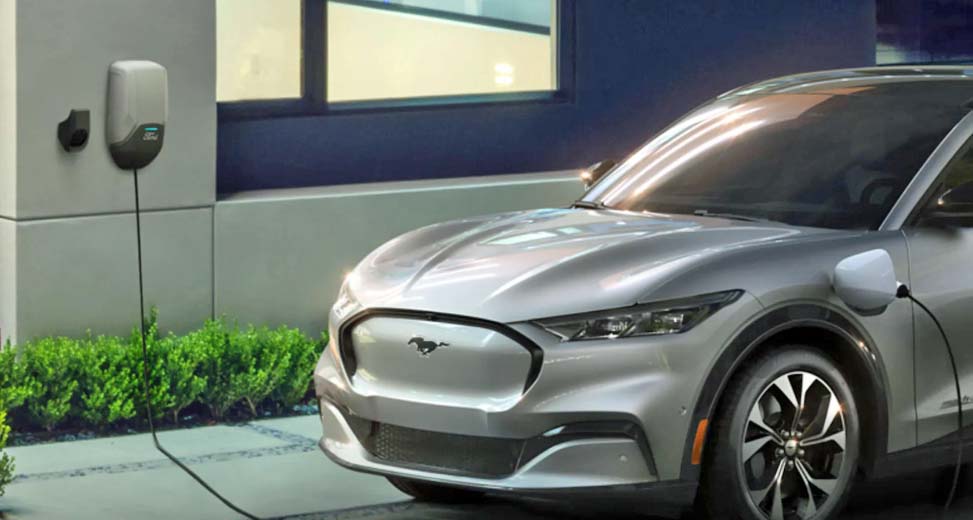The California utility Pacific Gas & Electric Company (PG&E) plans to test bidirectional charging technology in homes, businesses, and with local microgrids in select high fire-threat districts (HFTDs). The purpose of the pilots is to test the ability of electric vehicles (EVs) to send power back to the grid and to provide power to customers in the event of an outage.
Bidirectional charging technology allows EVs to draw power from the grid (or owner’s solar installation) for charging, or they can send it back to the grid. PG&E estimates that there are 400,000 EVs registered in its service area, which represents a valuable grid resource. Potentially, using the power stored in EV batteries could reduce the need to build new standalone energy storage systems.
Last month, PG&E announced collaborations with GM and Ford PG&E and GM to test vehicle-to-home capable electric vehicles and chargers. The pilot includes the use of bidirectional hardware coupled with software-defined communications protocols that will enable power to flow from a charged EV into a customer’s home, automatically coordinating between the EV, home, and PG&E’s electric supply. Ford has teamed up with Sunrun to enhance home energy management by making use of the onboard battery capability of the Lightning with Ford Intelligent Backup Power.
The three pilots, which are in addition to the collaborations with GM and Ford, will help to inform the Department of Energy Memorandum of Understanding that PG&E and a collaboration of industry, government, and labor leaders signed in April focused on accelerating “vehicle-to-everything” technologies.
“As electric vehicle adoption continues to grow, bidirectional charging technology has huge potential for supporting our customers and the electric grid broadly. We’re excited to launch these new pilots, which will add to our existing work testing and demonstrating the possibility of this technology,” said Jason Glickman, PG&E’s Executive Vice President, Engineering, Planning & Strategy.
PG&E estimates that the pilot programs will cost the utility approximately $11,700,000. Participants in the new pilot programs will be offered financial incentives for their participation, with additional benefits for those in disadvantaged communities, according to the utility. All three are expected to be available to customers in 2022 and 2023 and continue until incentives run out. PG&E will make more information available on its website, with pilots expected to begin in late summer 2022.
PG&E’s Bidirectional Charging Pilot Programs
Residential: In the pilot with residential customers, PG&E will work with automakers and EV charging suppliers to explore how light-duty, passenger EVs at single-family homes can help customers and the electric grid in various ways. These include providing backup power to the home if the power is out, optimizing EV charging and discharging to help the grid integrate more renewable resources, and aligning EV charging and discharging with the real-time cost of energy procurement. This pilot will be open to up to 1,000 residential customers who will receive at least $2,500 for enrolling, and up to an additional $2,175 depending on their participation.
Business: For business customers the pilot aims to explore how medium- and heavy-duty and possibly light-duty EVs at commercial facilities could help customers and the electric grid in various ways. These include providing backup power to the building if the power is out, optimizing EV charging and discharging to support the deferral of distribution grid upgrades, and aligning EV charging and discharging with the real-time cost of energy procurement. This pilot will be open to approximately 200 business customers who will receive at least $2,500 for enrolling, and up to an additional $3,625 depending on their participation.
Microgrid: Through the microgrid pilot, PG&E hopes to learn more about how EVs, plugged into community microgrids, can support community resiliency during Public Safety Power Shutoff events. Customers will be able to discharge their EVs to the community microgrid to support temporary power or charge from the microgrid if there is excess power. Following initial lab testing, this pilot will be open to up to 200 customers with EVs who are located in HFTD locations that contain compatible microgrids used during Public Safety Power Shutoff events. Customers will receive at least $2,500 for enrolling, and up to an additional $3,750 depending on their participation.
More details can be found here.
This content is protected by copyright and may not be reused. If you want to cooperate with us and would like to reuse some of our content, please contact: editors@pv-magazine.com.









This seems almost ironic when you consider PG&E was pushing for NEM 3. But maybe they’re ok with batteries because even though they’ll be paying out while the batteries are discharging into the grid, they’ll be getting the money back from customers while the batteries are charging. Whereas with residential solar, they only pay out to their customers.